A recently released report by the U.S. Census Bureau revealed that – while some employees have returned to the office – the number of people working remotely has tripled between 2019 and 2021, with many companies switching to a hybrid working model. The adoption of remote work during the pandemic offered greater mobility to employees who wanted to build a life outside the nation’s coastal urban centers.
As a result, these changes have allowed a new wave of cities to attract footloose techies and creatives. So, CoworkingCafe set out to find the best places for remote workers to move to in 2022. Specifically, our analysis rated U.S. cities across 10 metrics relevant to remote workers’ needs – including local internet speed and coverage; availability of coworking places; and cost of living (For more information about our analysis, check out the methodology section).
Highlights:
- Atlanta is the most attractive city for remote workers in 2022, ranking first across several metrics, including coworking and public Wi-Fi density
- Southern cities have the highest number of entries in the top 10, due to their lower cost of living and unrivalled entertainment scene
- Northeastern entries (Buffalo, N.Y. and Pittsburgh) offer great mobility to remote workers through easy access to multiple airports
Read on to learn more insights about our top 10 cities for remote workers.
Notably, given that living expenses play a large role in workers’ decisions to relocate, we filtered out cities that scored 110 or higher on the cost of living index. (A score of 100 represents the national average. Values below or above 100 indicate a lower or higher cost of living, respectively.)
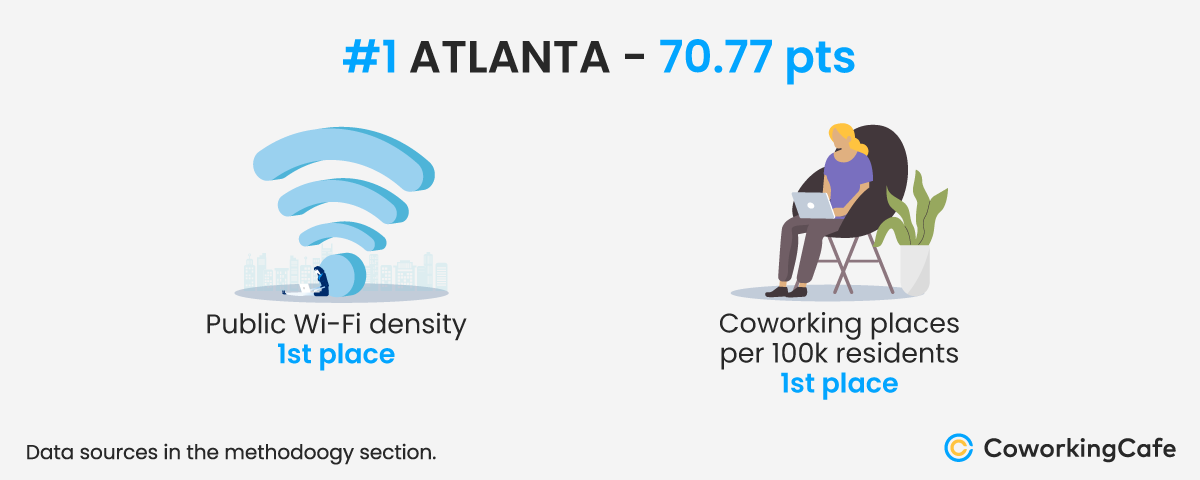
Atlanta leads the list with a total of 70.77 points and great performances across several metrics. Granted, the city has always been an exciting destination for those looking for the next step in their career, and some of the qualities it has built up for itself can also serve remote workers well.
For instance, the density of coworking places in Atlanta came out to 24 shared office spaces per 100,000 residents – the highest score among the cities on the list. Additionally, Atlanta boasted the highest availability of public Wi-Fi networks per 100,000 residents, which allows for maximum flexibility for freelancers and remote workers alike.
The city also ranked high for its local internet speed (second place, at 468.3 Mb/s), as well as its enticing entertainment scene (in third place, with 682 such establishments).
Moreover, since 2019, Atlanta has also been taking steps toward creating favorable conditions for startups, STEM research and technological innovation to flourish. Consequently, the city has simultaneously attracted more than a dozen Fortune 500 companies that employ both local and remote workers.
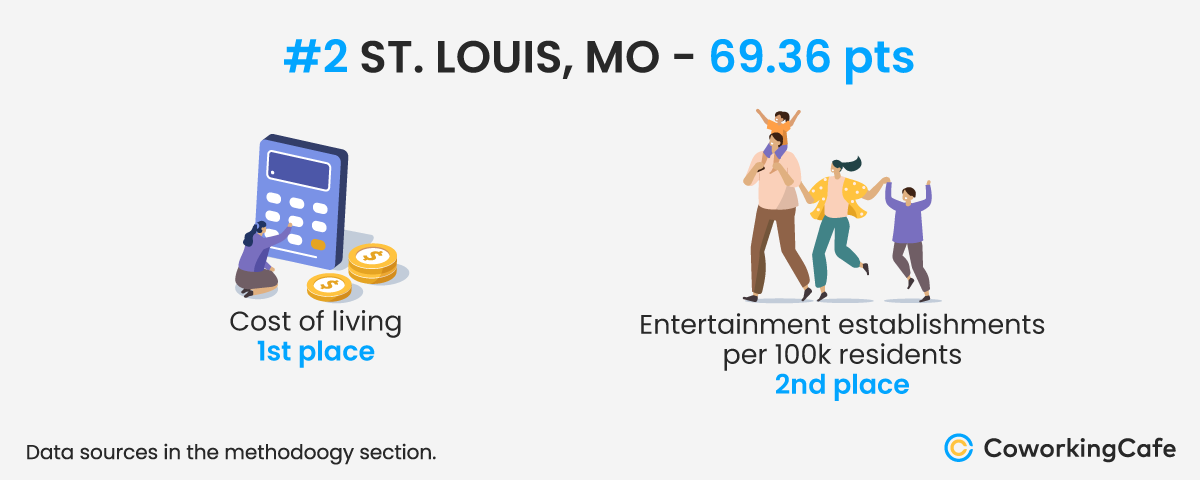
Next, according to a report by the Brookings Institute, St. Louis was among a select group of cities that caught the eye of many remote workers throughout the course of the pandemic. More precisely, there was a particular emphasis on the healthcare, biotechnology, aerospace, printing, publishing and electrical equipment manufacturing industries.
Fortunately, the city — which came in second on our list with a total of 69.36 points — was well-equipped to capitalize on the recent demographic shifts. To that end, St. Louis logged the lowest cost of living among the top 10 cities with average rents of roughly $1,113 per month, while also luring workers with its buzzing city life.
To put numbers to these performances, St. Louis occupied the second spot in our ranking for its density of entertainment establishments: It boasted 749 firms in this category per 100,000 residents, thereby living up to its reputation as a place for beer and baseball enthusiasts. Clearly, St. Louis is an idyllic location for curious minds and outdoor-loving families, providing tons of activities, from hiking to trips to Six Flags, the aquarium or its many museums.
Meanwhile, the city snatched third place for its walkability with a Walk Score of 65.7 points — just a point off of Buffalo, N.Y., in second place, and nearly double the score obtained by Birmingham, Ala. In particular, public infrastructure developments throughout the last decade have greatly increased St. Louis’ walkability. And, further progress in this area is expected in the coming years through the development of Chouteau Greenway Project, which will connect parks and public spaces via a system of urban lakes, wetlands and trails along the urban core.
In terms of the coworking scene in St. Louis, the spread of shared properties here was average compared to the other cities on the list, with 11 hubs per 100,000 residents.
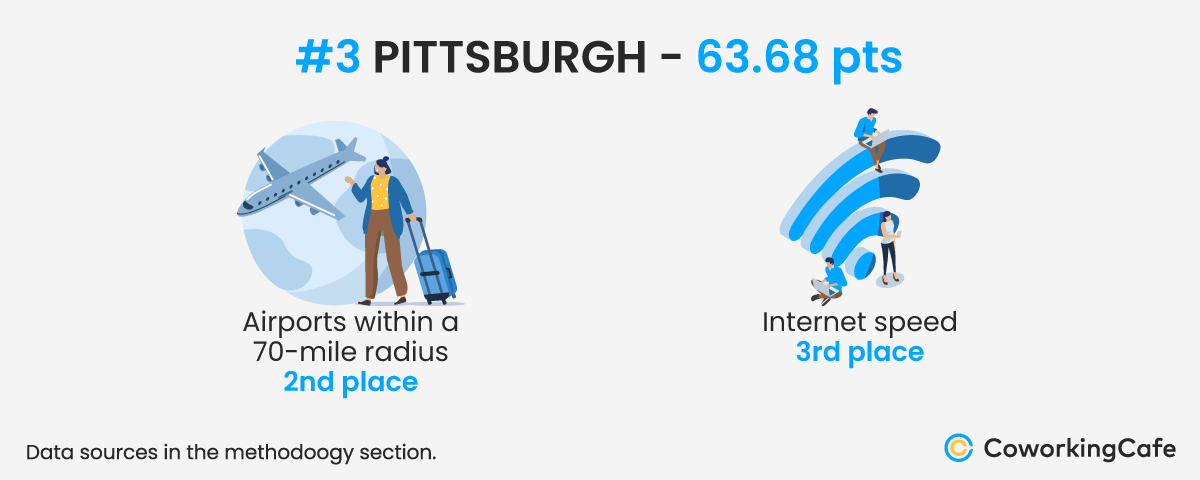
Pittsburgh secured the third spot on our list, garnering 63.68 points with consistently above-average performances across most indicators. For instance, the city ranked third for internet speed with an average of 443.41 Mb/s. It also occupied the fourth position in terms of the density of entertainment establishments — 677 per 100,000 residents.
Additionally, although remote workers don’t have to worry about daily commutes, mobility that allows one to be in the office when required is still vital, as many businesses prefer a hybrid work schedule. Therefore, access to regional or even international airports gives these professionals a bridge to the world’s busiest hubs. In that respect, Pittsburgh has no fewer than four airports within a 70-mile radius — Pittsburgh International Airport, Arnold Palmer Regional Airport, Morgantown Municipal Airport and Johnstown-Cambria County Airport — ranking second for this indicator.
A former steel manufacturing city, Pittsburgh has reinvented itself as a growing tech and robotics hub with top computer science programs at Carnegie Mellon University and the University of Pittsburgh. Accordingly (and for remote workers who are also keeping an eye on the job market within their new location), the Pennsylvania city has been enjoying a growing presence of engineering and big tech companies, like Google, IBM, Apple, Michael Baker International Inc. and Hitachi Rail. And, as a signal of the local economy’s growing prospects, Pittsburgh placed fourth overall for its unemployment rate.
Add to that the diverse landscape of the surrounding area; access to several parks and green spaces within the city; and major league sports teams to cheer on and you’ve got yourself a potent mix for a rising-star city.
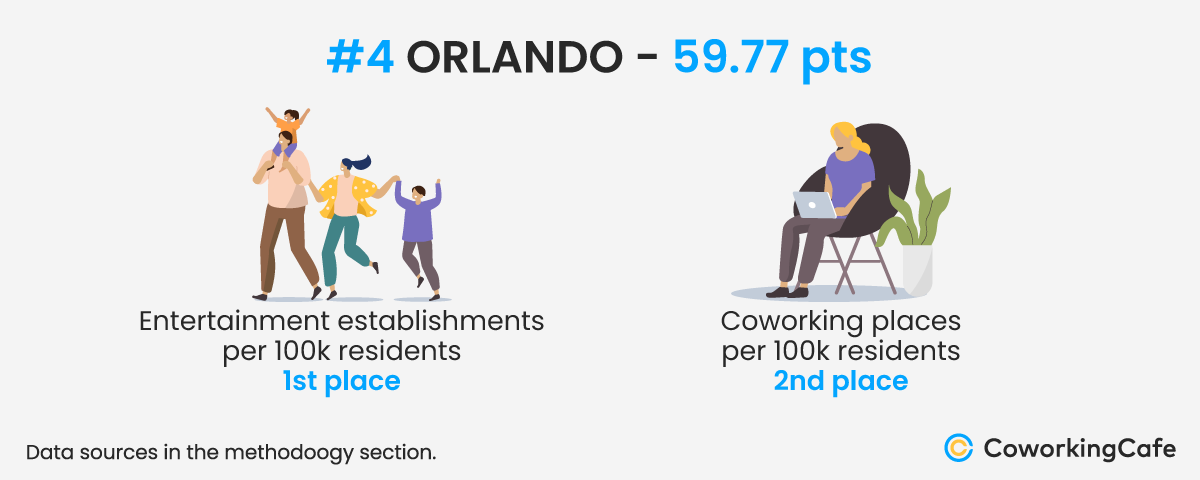
Not far behind, Orlando, Fla., occupied the fourth spot, earning the highest-ranking of the two Florida entries on our list. (Tampa came to rest in sixth place, just outside of the top five.) A good portion of Orlando’s total score came as the result of excellent performances in terms of its robust coworking and entertainment scene.
For example, Orlando was #1 on our list with 829 entertainment establishments per 100,000 residents — a significant lead compared to the runner-up, St. Louis, at 749. Additionally, Orlando came in third for its density of public Wi-Fis (20 networks per 100,000 residents).
Likewise, those interested in stable and secure internet connections and a professional environment will be glad to learn that the coworking market in Orlando also had a strong showing with 14 such workspaces per 100,000 residents. That gave the city the second-highest value for this indicator among those on our list.
Interestingly, according to a recent national report, self-storage rental rates soared in Sunbelt cities, like Orlando. This might suggest that these urban centers have attracted a significant number of remote workers throughout the pandemic. And, while this might not help the city’s situation as far as its cost of living (Orlando placed ninth out of 10 for this metric), it’s an example of its popularity with the new wave of flexible workers.
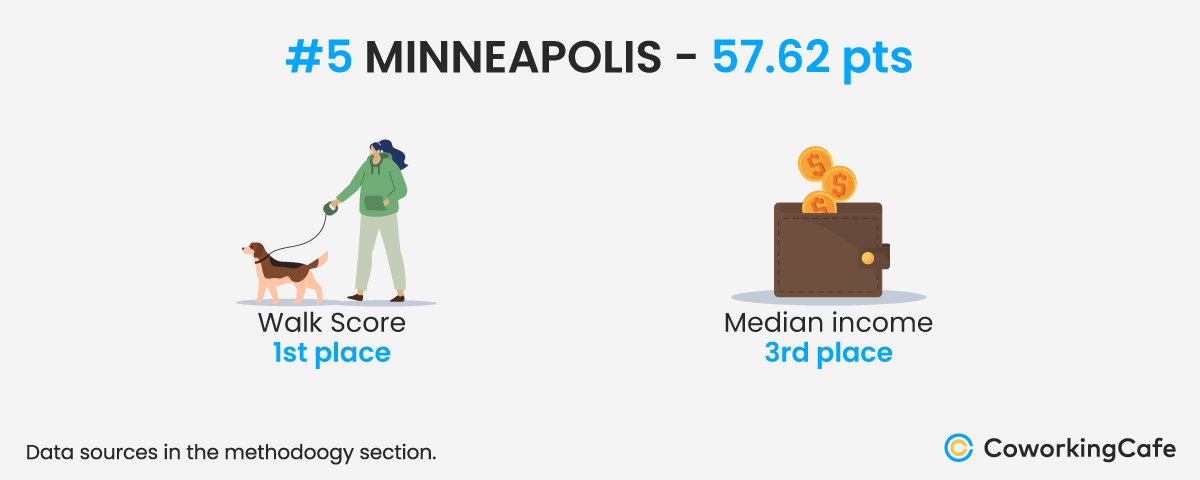
In fifth place, Minneapolis totaled 57.62 points, snatching first place for the highest Walk Score among the entries on our list. It also had a strong showing in terms of the local median income, coming in third place.
Here, every resident in Minneapolis is within six blocks of a park. As such, the city is very popular with people who love the outdoors, as well as families with kids and pets. Likewise, the area has a bevy of local microbreweries in the hip North Loop, as well as a vibrant arts and music scene. Consequently, Minneapolis ranked seventh for its entertainment metric, with 592 establishments per 100,000 residents.
#6 Tampa – 56.66 pts
Tampa, Fla. garnered 56.66 points, with a great showing in terms of its internet coverage (100% coverage, sharing the top spot for this metric with Cincinnati and Buffalo, N.Y.).
Tampa, Fla. was also the runner-up for two additional indicators. With an unemployment rate of 5.3% – for which it gathered 4.14 out of 5 points – and a yearly median income of $41,792, the Floridian city trailed Atlanta for both metrics.
Finally, Tampa’s 12 coworking places to every 100,000 residents earned it third place for this indicator among the entries, just behind Orlando.
#7 Cincinnati – 54.43 pts
Beside its shared first spot for internet coverage, Cincinnati also placed fourth for coworking density, and fifth for the number of entertainment establishments per 100,000 residents. Additionally, the city also garnered points for its cost of living (fifth place, just below Richmond, Va.) and its Walk Score (sixth place).
#8 Richmond – 54.42 pts
With a total score that ended up being incredibly close to that of Cincinnati, Richmond managed to outrank the Ohioan city on a couple of metrics.
For instance, Richmond placed fourth for cost of living and fifth in terms of its Walk Score, ahead of Cincinnati. On top of that, it also took second place for its density of public Wi-Fis (27 to 100,000 residents), as well as fourth place for internet speed.
#9 Birmingham – 53.79 pts
Remote workers considering a move to Birmingham, Ala. will be glad to know that internet speed won’t be an issue. At 493.77 Mb/s, the city’s performance for this indicator was unmatched across the top 10.
In terms of affordability and living costs, the Alabaman city is an attractive destination, outranked only by St. Louis.
#10 Buffalo, N.Y. – 52.49 pts
Those who need to travel for work are spoilt for choice in Buffalo, N.Y., as the city offers access to five different airports within a 70-mile radius. Buffalo placed first for this indicator, ahead of Pittsburgh.
It also earned second place for its Walk Score and boasted the third lowest living costs among the top 10 cities.
Atlanta Pulls Off Top Performances Across Multiple Indicators
A quick survey of the best-performing cities across the study’s metrics revealed some interesting highlights: First, Atlanta claimed the #1 spot for four of the 10 indicators, including the density of its coworking places and public Wi-Fis, as well as the local median wage.
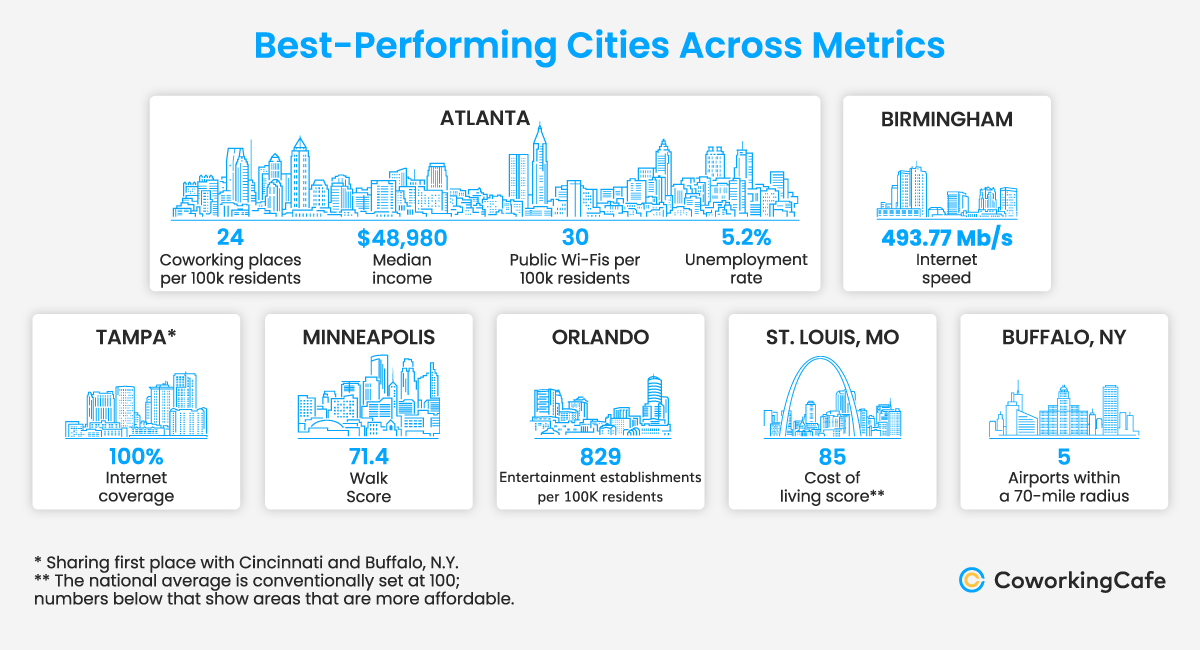
Meanwhile, St. Louis proved to be the most affordable location among the cities on our list, followed by Birmingham, Ala., Buffalo, N.Y. and Richmond, Va.
Additionally, Buffalo, N.Y., snatched first place for the most options in terms of air transportation options for remote workers who need a quick link to their employer’s headquarters or worldwide business partners.
Lovers of the outdoors and those who wish to live in more walkable communities need to consider Minneapolis, which garnered the highest total for its Walk Score indicator.
Fittingly, Orlando, Fla., boasted the highest density of entertainment establishments (900 such venues per 100,000 residents), as well as the second-highest coworking density among the entries on our list.
As far as internet coverage provided by each entry, three cities shared the top spot and received maximum points for 100% coverage: Tampa, Fla.; Cincinnati; and, once again, Buffalo, N.Y.
Finally, Birmingham, Ala. — which ranked ninth — boasted the highest internet speed within the top 10 at 493.77 Mb/s.
A thriving coworking scene always plays a key role in the productivity and flexibility of flex workers, as many want the option to work from a dedicated space, as well as on their own terms and according to their own needs. To that end, remote workers can explore a wide range of local coworking spaces via CoworkingCafe.com.
Methodology
Points for all indicators were distributed directly proportional to their value, except for the cost of living and the unemployment rate indicators, for which points were awarded in inverse proportion. Entries could earn a maximum of 100 points, allocated as follows:
“Coworking Density” – This indicator represents the ratio of coworking places available for 100,000 residents within the city. Values scored were as of August 2022 CommercialEdge Commercial Reports. The maximum weight for this metric was 15 points.
“Density of Entertainment Establishments” – Based on Census Business Patterns 2020, ZIP-level summed up for cities. NAICS codes: 7111, 7112, 7121, 7131, 7139, 7224, 7225. Once the numbers per city were established, we created a ratio in which we highlighted the number of establishments per 100,000 citizens within each location. The maximum weight for this metric was 15 points.
NAICS codes and titles used to define entertainment establishments
“7111//” – Performing Arts
“7112//” – Spectator Sports
“7121//” – Museums, Historical Sites and Similar Sites
“7131//” – Amusement Parks and Arcades
“7139//” – Other Amusement and Recreation
“7224//” – Drinking Places (Alcoholic)
“7225//” – Restaurants and Other Places to Eat
“Cost of Living” – Measures the affordability of a region by comparing it to a national average, conventionally set at 100. Cities with lower values correspond to more affordable regions. Values scored as per the C2ER Cost of Living report for Q1 2022. Our analysis was based only on cities with an index of less than or equal to 110. The maximum weight for this metric was 15 points.
“Walk Score” – Measures the walkability of any address using a patented system. For each address, Walk Score analyzes hundreds of walking routes to nearby amenities. Points were awarded based on the distance to amenities in each category. Amenities within a five-minute walk (.25 miles) were given maximum points. A decay function was used to give points to more distant amenities, with no points given after a 30-minute walk.
Walk Score also measures pedestrian friendliness by analyzing population density and road metrics, such as block length and intersection density. Data sources include Google, Factual, Great Schools, Open Street Map and the U.S. Census. The maximum weight for this metric was 10 points.
“Internet Speed” – Expressed in b/s. Values scored as per data provided by BroadbandNow. The maximum weight for this metric was 10 points.
“Internet Coverage” – Values scored as per data provided by BroadbandNow. The maximum weight for this metric was 10 points.
“Public Wi-Fi Density” – Ratio of free public Wi-Fis available per 100,000 residents within the city. Values scored as per data provided by wififreespot.com. The maximum weight for this metric was 10 points.
“Airports Within 70 Miles” – Using closestairportto.com, we checked the number of airports at a maximum distance of 70 miles from each city in our analysis. Values scored as per closestairport.com. The maximum weight for this metric was 5 points.
“Unemployment Rate” – The percentage of those unemployed and actively searching for a job. Values scored were 2021 U.S. Census Bureau percentages. The maximum weight for this metric was 5 points.
“Income” – Median earnings in the past 12 months (in 2021 inflation-adjusted dollars) for population aged 16 years and older with earnings. Values scored as per 2021 U.S. Census Bureau data. The maximum weight for this metric was 5 points.
While the paychecks of employees working remotely are rarely tied to the average wage in their current location, we included data about median incomes and the unemployment rate for the cities on our list as an indicator of the local economy’s status. Additionally, locations with robust performances across these indicators could potentially provide local employment alternatives to these professionals, thereby increasing their advantage.







